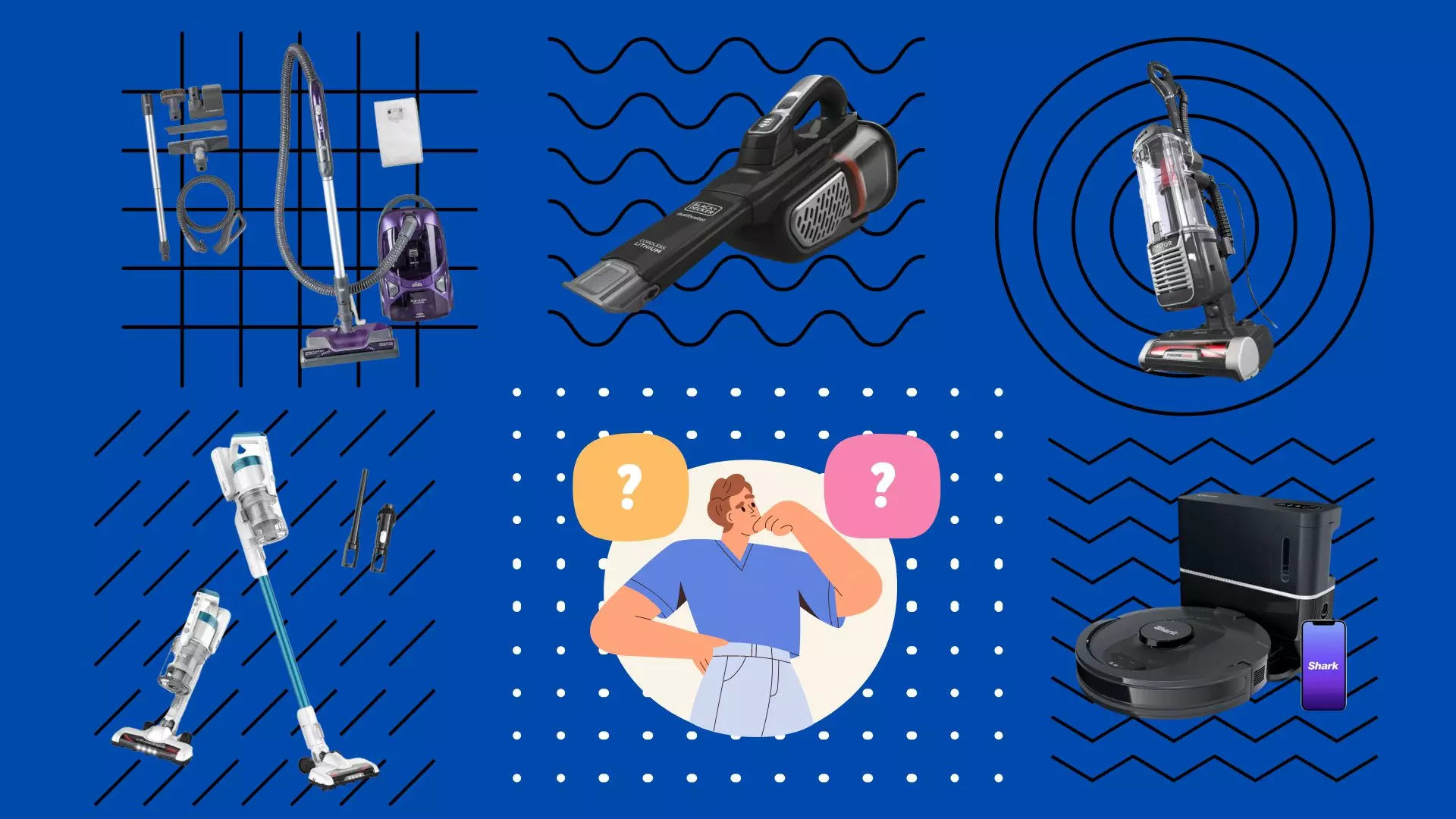Buying the right vacuum cleaner is very important as you must constantly interact with it. So, consider a few things before running to the store and buying your first vacuum cleaner.
I want to start with what types of vacuum cleaners there are so that you know what you can choose from. After that, we will discuss the pros and cons of each type of vacuum cleaner. I will also give you the main parameters you need to make your decision based on. At the end of this article, you will also get an idea of the prices of popular vacuum cleaner models.
Please note that this article focuses on purchasing a home vacuum cleaner. I do not touch on the topic of installing a centralized vacuum cleaner or different professional solutions.
Quick vacuum types description
Let’s look at the most common types of vacuum cleaners:
Upright Vacuum Cleaners
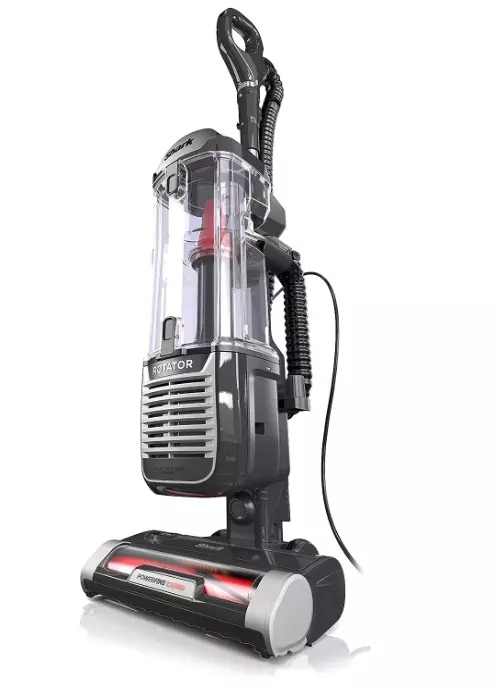
Upright Vacuum Cleaners: Upright vacuum cleaners are one of the most common and traditional types. They stand upright and are equipped with a motorized brush roll for effective carpet cleaning. Upright vacuums often have strong suction power and larger dustbins, making them ideal for larger homes with mostly carpeted areas. They may also come with attachments for cleaning upholstery and hard-to-reach spaces.
- Upright vacuums excel at deep cleaning carpets due to strong suction and motorized brush rolls.
- They offer wide cleaning paths for faster coverage and integrated attachments for versatile cleaning.
- Models with HEPA filters effectively trap allergens, making them suitable for allergy sufferers.
- They can be heavy to maneuver and generate more noise compared to other types.
Canister Vacuum Cleaners
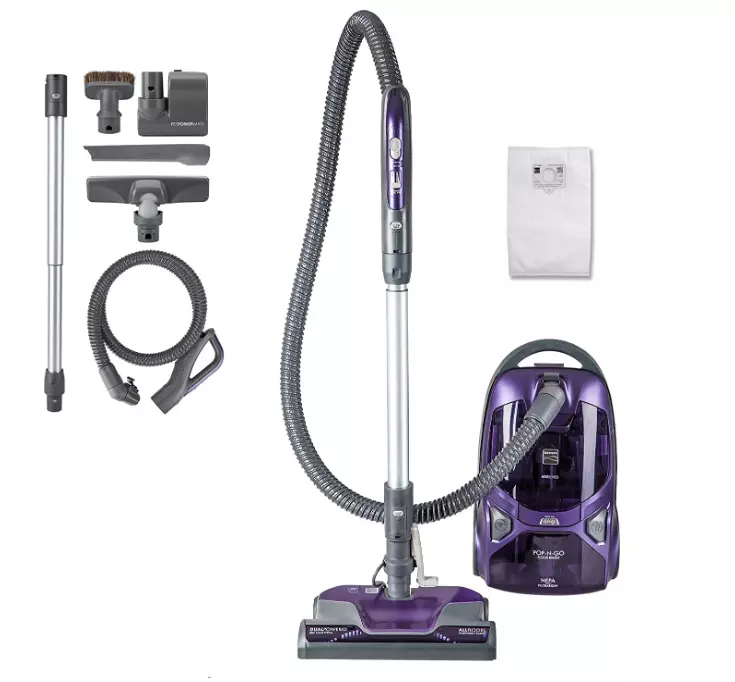
Canister Vacuum Cleaners: Canister vacuum cleaners consist of a main unit connected to a flexible hose. The canister, which contains the motor and dustbin, is usually on wheels for easy maneuverability. These vacuums are versatile and suitable for various surfaces, including carpets, hardwood floors, and stairs. They often come with a range of attachments for specialized cleaning tasks.
- Canister vacuums come with various attachments for thoroughly cleaning various surfaces.
- The separate canister and hose design allows easy navigation and tight space access.
- Their bulkier canister can be cumbersome to store, and assembling attachments might take time.
- They’re suitable for delicate floors like hardwood and offer adjustable suction settings.
Stick Vacuum Cleaners
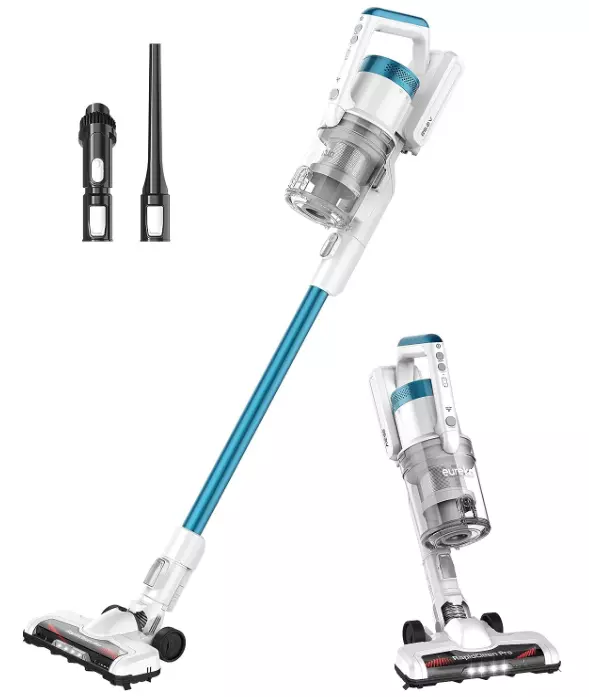
Stick Vacuum Cleaners: Stick vacuum cleaners are lightweight, slim, and convenient for quick clean-ups. They are suitable for smaller living spaces and homes with minimal carpeting. While they might not have the same level of power as upright or canister vacuums, they are easy to maneuver and store. Stick vacuums are ideal for tackling light dirt and debris on hard floors and low-pile carpets.
- Stick vacuums are easy to maneuver and suitable for quick clean-ups.
- Their slim design makes them easy to store in small spaces or closets.
- While great for light cleaning, they may lack the suction power of larger models.
- Many stick vacuums are cordless, providing freedom of movement without cords.
Handheld Vacuum Cleaners
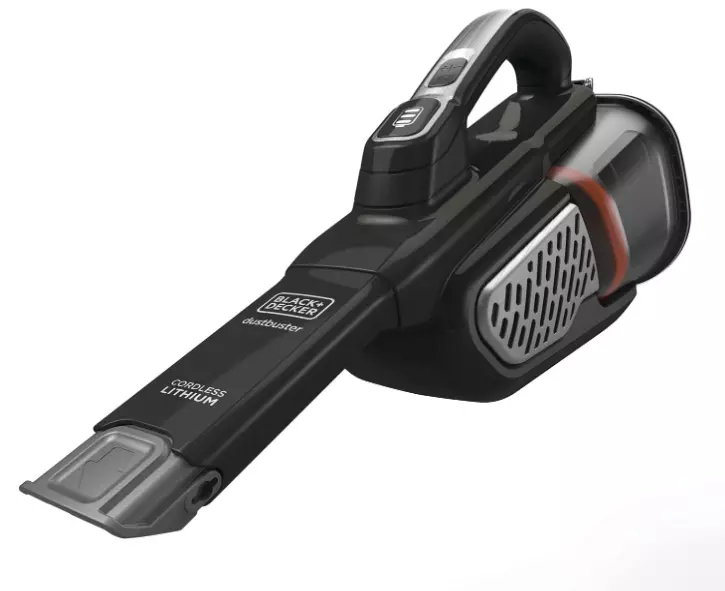
Handheld Vacuum Cleaners: Handheld vacuum cleaners are small, portable devices designed for quick and easy spot cleaning. They are great for cleaning car interiors, upholstery, stairs, and other hard-to-reach areas. Handheld vacuums are not typically suitable for large-scale cleaning due to their limited capacity, but they are convenient for handling small messes.
- Handheld vacuums are perfect for quick spot cleaning and reaching tight spaces.
- Their small size makes them easy to carry around, including for cleaning car interiors.
- Due to their compact design, they may need more frequent emptying.
- Handheld vacuums are ideal for small tasks but might lack the power for extensive cleaning.
Each type of vacuum cleaner has its own strengths and limitations, so understanding your cleaning needs and the specific features of each type will help you choose the most appropriate option for your home.
Which cleaner is best for which floor
The first thing you should consider when choosing a vacuum cleaner is what kind of surface you will be vacuuming. The fact is that different types of vacuum cleaners are suitable for different surfaces. Below you will find a table showing the flooring types suitable for vacuum cleaners.
| Flooring Type | Best Vacuum Types | Additional Considerations |
|---|---|---|
| Carpets | Upright, Canister | Carpets tend to trap dust and debris, so vacuum types with strong suction and motorized brush rolls are essential. Upright vacuums are particularly effective due to their powerful suction and wide cleaning paths. Canister vacuums with a motorized power head also excel on carpets. Consider adjustable height settings for different pile depths. |
| Hardwood Floors | Canister, Stick | Opt for vacuum cleaners with adjustable suction settings to protect delicate hardwood floors from scratches. Canister vacuums with a variety of attachments, like soft brush rolls, ensure gentle and effective cleaning. Stick vacuums are also suitable, with their lightweight design and soft bristles to prevent damage. |
| Tile/Vinyl Floors | Canister, Stick, Robot | Tile and vinyl floors are relatively easy to clean. Canister vacuums offer versatile attachments for various surfaces, while stick vacuums provide lightweight maneuverability. Robot vacuums equipped with sensors can navigate these surfaces efficiently. Choose models with rubber wheels to prevent scratching. |
| Laminate Floors | Canister, Stick, Robot | Similar to hardwood floors, laminate surfaces require gentle suction to avoid damage. Canister and stick vacuums are well-suited, and robot vacuums can be programmed for regular maintenance. Consider using soft brush attachments and avoiding excessive water if using wet/dry features. |
| Area Rugs | Canister, Stick, Robot | Area rugs come in various pile heights and materials. Canister and stick vacuums with adjustable settings accommodate different rug types. Robot vacuums can be effective, but ensure they have sensors to avoid getting tangled in rug fringes. Be cautious with high-pile rugs, as some vacuums may struggle. |
| Stairs | Handheld, Canister, Stick | Stairs are often challenging to clean due to limited space. Handheld vacuums are ideal for quick spot cleaning. Canister and stick vacuums offer maneuverability, especially if they come with attachments suitable for stairs. Consider lightweight options to prevent strain during cleaning. |
Advantages and disadvantages of each vacuum type
Each type of vacuum cleaner has its own advantages and disadvantages, which should be carefully considered based on your specific cleaning needs, preferences, and lifestyle. Here’s a breakdown of the pros and cons of each vacuum type:
Upright Vacuum Cleaners
Upright vacuum cleaners are a good choice for large homes, as they allow you to vacuum both flat floors and carpets due to the fact that the vacuum cleaner stands upright and is equipped with a motorized brush shaft that agitates and removes dirt from carpets. The powerful suction power allows for excellent deep cleaning of carpets and large areas. Upright vacuum cleaners usually come with attachments, allowing them to be used to clean a variety of surfaces and tasks.
However, their bulkiness can limit maneuverability, and they can be noisier than other types of vacuums. Also, because these vacuums are heavy, they may not be suitable for easily scratched surfaces.
Advantages:
- Powerful suction: Upright vacuums usually have strong suction and motorized brushes, making them effective for deep cleaning carpets.
- Larger capacity: They often have larger dustbins or bags, reducing the frequency of emptying.
- All-in-one design: Many models come with attachments for versatile cleaning, including upholstery and crevices.
- Faster cleaning: Their wide cleaning path allows you to cover more surface area quickly.
Disadvantages:
- Heavy and bulky: Upright vacuums can be heavy and less maneuverable, especially on stairs or in tight spaces.
- Limited reach: The design may not easily reach under furniture or into corners.
- Noise level: Upright vacuums can be louder due to their powerful motors.
- Not ideal for hard floors: Some models might struggle with delicate hardwood floors.
Best Upright Vacuum Cleaners
Dyson Ball Animal 3 Extra
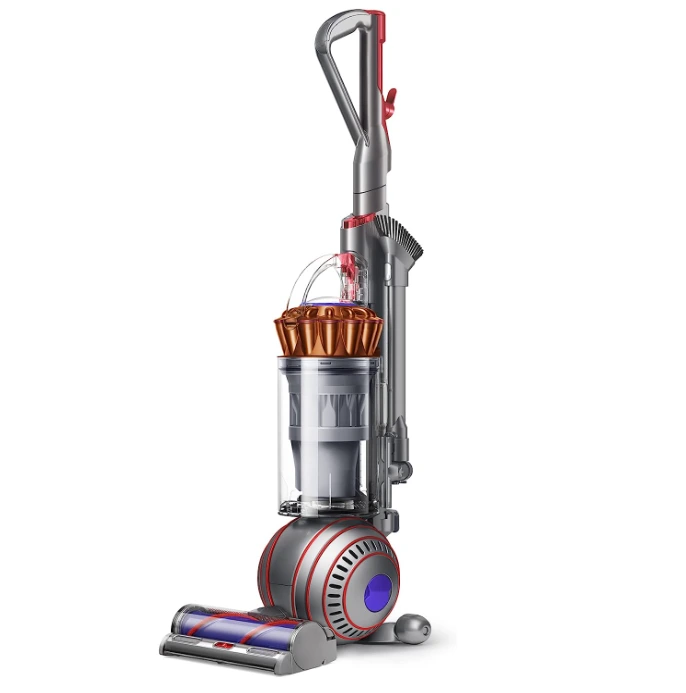
Price: $483.9
Advantages:
- Pet Groom Tool
- Floorhead has three suction gate settings
- Brush roll-off switch
Disadvantages:
- Build quality
- No automatic power cord retraction system
- Heavy and big size
Shark AZ3002 Stratos
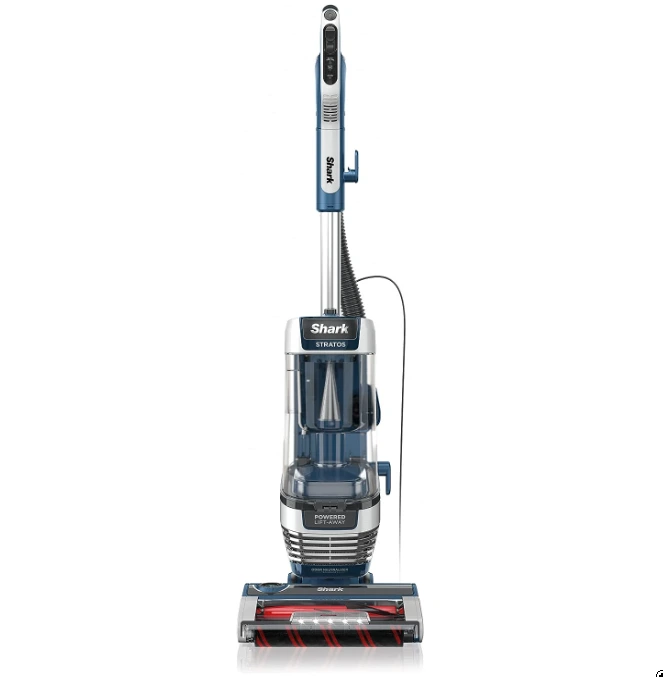
Price: $487.34
Advantages:
- The “Lift-Away” design lets you pick up and carry its canister body without a floorhead.
- Odor neutralization system
- The vacuum’s primary brush roll has a set of integrated fins to remove hair easily.
Disadvantages:
- Fewer attachments that in the Dyson vacuum
- Floorhead, with no brush roll height adjustment
- The roller itself isn’t removable
Canister Vacuum Cleaners
Canister vacuum cleaners are the epitome of versatility. With a detachable main unit connected by a flexible hose, they can easily tackle surfaces ranging from wooden floors to carpets. Their maneuverability allows them to tackle hard-to-reach places and corners, making them suitable for all-in-one cleaning.
Although their large size may require additional storage, their ability to adapt to different cleaning needs is undeniable. These vacuums will suit you if you have many different hard-to-reach places that larger vacuums simply can’t reach.
Advantages:
- Versatility: Canister vacuums come with a range of attachments, making them suitable for various surfaces and cleaning tasks.
- Maneuverability: The separate canister and hose allow for more flexibility and easier maneuvering.
- Quiet operation: The motor is often housed in the canister, reducing noise during cleaning.
Disadvantages:
- Bulky canister: The canister itself can be cumbersome to move around.
- Storage: Storing both the canister and hose can be challenging in smaller spaces.
- Assembly: Setting up and attaching the hose and accessories might take more time.
Best Canister Vacuum Cleaners
Miele Compact C1

Price: $429.03
Advantages:
- AirClean Sealed System to prevent the release of fine dust and dirt
- Six power settings
- 2 years warranty
Disadvantages:
- High price
- Not good for Berber carpets
- High noise level
Sanitaire SC3683D
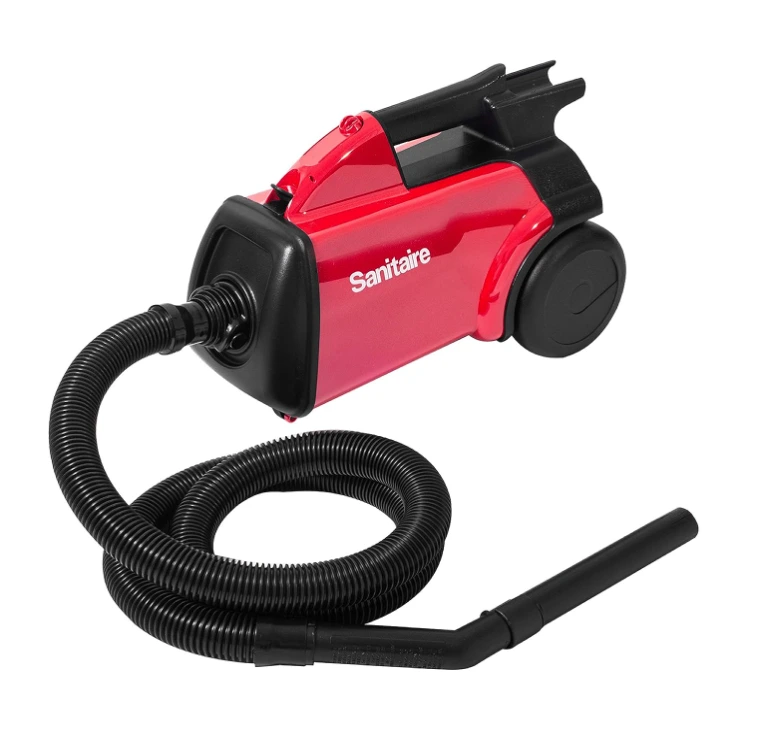
Price: $487.34
Advantages:
- Filter HEPA 68905 (Optional)
- 15-foot cord
- Price
Disadvantages:
- Not good for any carpets
- Build quality
Stick Vacuum Cleaners
Stick vacuums are lightweight and nimble, making them ideal for quick cleanup. Their thin and lightweight design glides easily across hard floors and low-pile carpets, quickly removing dust and debris. While they don’t have as much power as bulkier models, their convenience and maneuverability make them indispensable for keeping your living spaces clean.
However, you should keep in mind that they typically last for 60 minutes on a single battery. So they are not suitable for long cleaning sessions. Another significant disadvantage is that they don’t do well with carpets, so this vacuum cleaner is more suitable for a carpet-free home.
Advantages:
- Lightweight and compact: Stick vacuums are easy to maneuver and store.
- Quick clean-ups: These vacuums are ideal for light and frequent cleanings, especially on hard floors.
- Cordless options: Many stick vacuums are cordless, providing greater freedom of movement.
Disadvantages:
- Limited power: Stick vacuums might not have the same suction power as upright or canister models.
- Smaller dustbins: Their smaller capacity requires more frequent emptying.
- Short battery life: Cordless models can have limited run time, requiring recharging.
Best Stick Vacuum Cleaners
Shark IX141 Pet
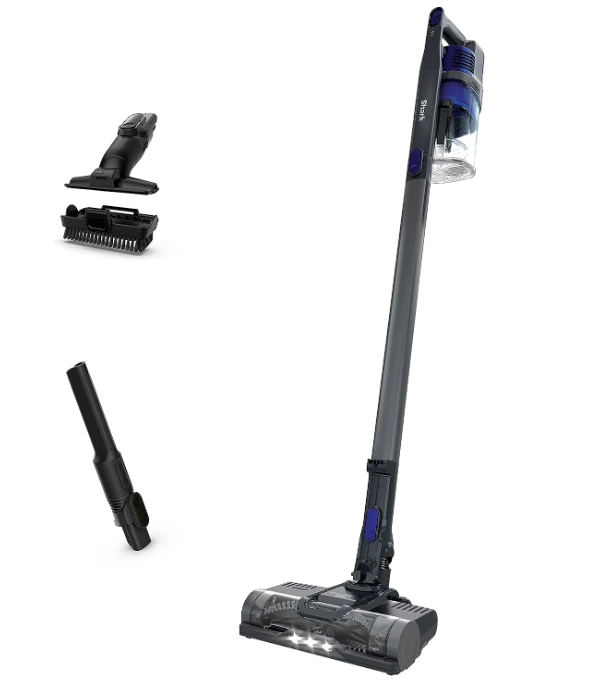
Price: $199.99
Advantages:
- Weight – 4.7 lbs
- Hepa filter
- Cordless
Disadvantages:
- Power – 181 watts
- Capacity (0.30 liters)
- Battery life
BLACK+DECKER Powerseries Extreme
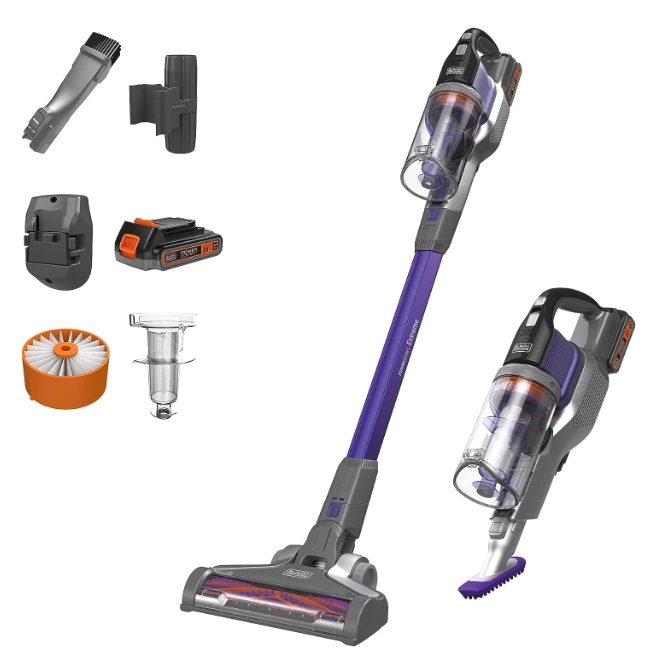
Price: $153.40
Advantages:
- A lot of accessories
- Battery life
- Cordless
Disadvantages:
- Weight – 10.6 lbs
- No HEPA filter
Handheld Vacuum Cleaners
Portable vacuum cleaners are designed for quick cleanup. Their compact size and lightweight design allow them to tackle spills, crumbs, and dirt quickly. Ideal for upholstered furniture, stairs, and tight spaces. Despite their limited capabilities, their convenience and ease of use make them indispensable for removing small dirt with minimal effort.
It is worth saying that this is not the vacuum cleaner you will use to clean your entire house (unless you have a few hours to spare). Also, these vacuum cleaners do not have a very large battery and are unlikely to cope with anything more complicated than a pile of dust and crumbs.
Advantages:
- Portability: Handheld vacuums are lightweight and easy to carry for quick clean-ups.
- Versatility: They’re great for small spaces, upholstery, and car interiors.
- Reachability: Handheld vacuums can access tight corners and spaces.
Disadvantages:
- Limited capacity: Their small dustbins require frequent emptying.
- Less power: Handheld vacuums might have lower suction power compared to larger models.
- Not suitable for large areas: They are more suitable for spot cleaning rather than full-room cleaning.
Best Handheld Vacuum Cleaners
BLACK+DECKER dustbuster
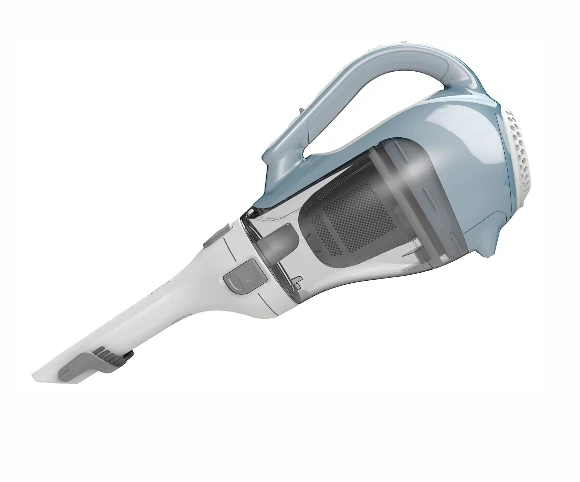
Price: $59.99
Advantages:
- Low price
- A dustbin is bigger than in other vacuums
- Cheap replacement filters
Disadvantages:
- Fewer attachments
- Unreplaceable battery
- Long charging time
Shark UltraCyclone Pet Pro Plus
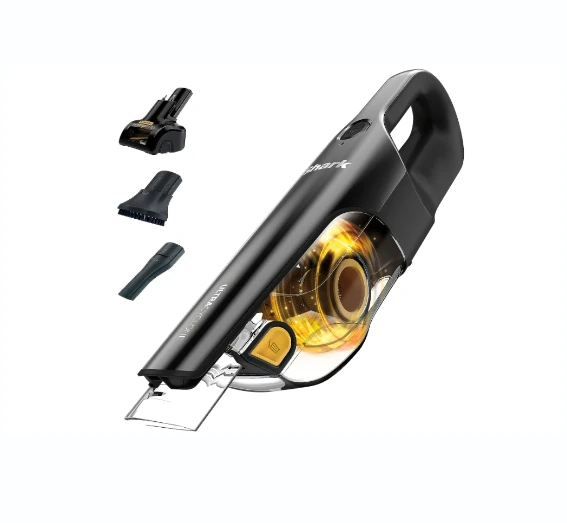
Price: $89.99
Advantages:
- Small size
- A lot of attachments
- Big dirt compartment
Disadvantages:
- 10 minutes battery life
- Unreplaceable battery
- Bad sealing in particles like pet dander or dust
Ultimately, the best vacuum type for you depends on factors such as your home’s layout, the types of surfaces you have, your cleaning habits, and any specific cleaning challenges you face. Consider these advantages and disadvantages in the context of your needs to make an informed decision.
What to consider when choosing a vacuum cleaner?
Here are a few things you should keep in mind before you start choosing your new vacuum cleaner.
Attachments
Attachments significantly enhance a vacuum cleaner’s versatility. Look for a variety of attachments like crevice tools, upholstery brushes, and extension wands. Crevice tools are perfect for narrow spaces, while upholstery brushes are designed to clean furniture and curtains.
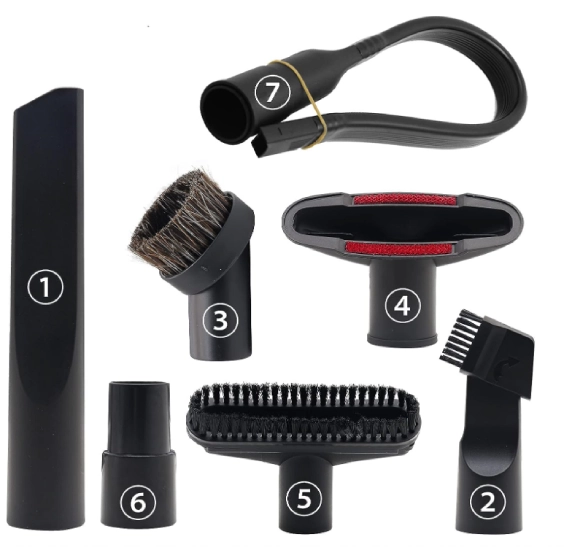
Extension wands help you reach high or awkward areas. Having a diverse set of attachments ensures that your vacuum can tackle a wide range of cleaning tasks effectively.
Brush Roll Switch
A brush roll switch is a valuable feature, especially if your home has a mix of carpets and hard floors. Being able to turn off the motorized brush when transitioning from carpets to hard floors prevents scattering debris and helps protect delicate flooring.
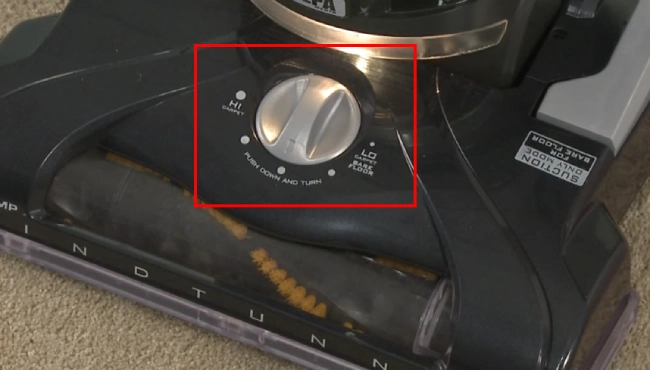
This feature ensures optimal cleaning results without causing any damage to different types of surfaces. These brushes can be found on all types of vacuum cleaners except handheld and robot vacuum cleaners.
Filters
Filters play a vital role in maintaining indoor air quality while vacuuming. High-Efficiency Particulate Air (HEPA) filters are the gold standard for trapping small particles and allergens. They are especially beneficial for homes with pets or allergy sufferers. Regularly cleaning or replacing filters is essential to maintain the vacuum’s efficiency and ensure the cleanest air output.
Cord Control
The length of the vacuum cord is essential for covering larger areas without needing to change power outlets frequently. Some models also come with cord management features such as cord retractors or clips to keep the cord organized during storage. This feature prevents tangling and ensures that your vacuum is always ready for use without hassle.
Bagged vs Bagless
The choice between bagged and bagless vacuums depends on your preferences. Bagged vacuums maintain better hygiene as the bag traps dirt and allergens, but you’ll need to purchase replacement bags. Bagless vacuums are more convenient since you don’t need to buy bags, but you’ll have to empty the dustbin regularly and clean or replace filters to maintain efficiency.
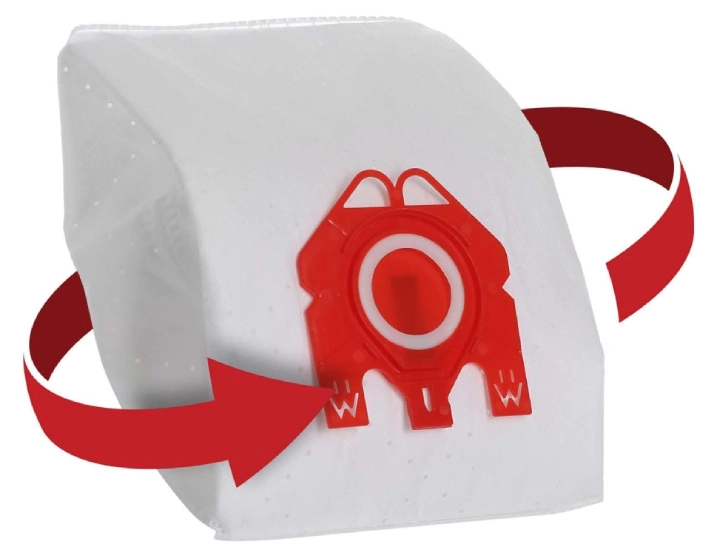
If you are not allergic to dust or if your house is not very dirty and you clean often, you can buy yourself a Bagless vacuum cleaner. On the other hand, if you are more sensitive to dirt and dust, you should consider buying a Baged vacuum cleaner.
Cordless
Cordless vacuums offer unparalleled mobility and convenience. When considering a cordless model, check the battery life to ensure it can cover your cleaning needs without frequent recharging. Also, consider the charging time – a shorter charging time means less downtime between cleaning sessions. Cordless vacuums are great for quick clean-ups and reaching areas where cords might be inconvenient, but they might not be suitable for extended cleaning sessions due to battery limitations.
What about robotic vacuum cleaners?
Robot vacuum cleaners are good extras to keep the house in order. They work autonomously, and with the help of special sensors, they find dust in the room and clean it themselves. Also, a nice bonus is that you can set them to work while you are away from home. This will allow you to return to a clean home without worrying about extra cleaning.
Among the cons, I can mention the rather high price tag. Good work vacuum cleaners start from $300-$400. In addition, a robot vacuum cleaner is not the best choice if you have a house with several floors or high thresholds between rooms. They won’t be able to go up or down the stairs, nor will they be able to drive over a high threshold.
As I mentioned before, a robot vacuum cleaner is more of an extra vacuum cleaner that will allow you to clean less often. However, it will not be able to clean your home as thoroughly as a regular vacuum cleaner.
Advantages:
- Autonomous cleaning: Robot vacuums can clean your floors while you’re away or busy with other tasks.
- Convenience: They can access tight spaces and under furniture.
- Regular maintenance: Robot vacuums help with daily upkeep, reducing the need for manual cleaning.
Disadvantages:
- Limited deep cleaning: They might not replace manual deep cleaning sessions.
- Obstacle detection: Some models might struggle with complex layouts or unexpected obstacles.
- Maintenance: Robot vacuums need regular upkeep, including emptying their bins and cleaning brushes.
Best robot vacuum cleaners
iRobot Roomba j7+
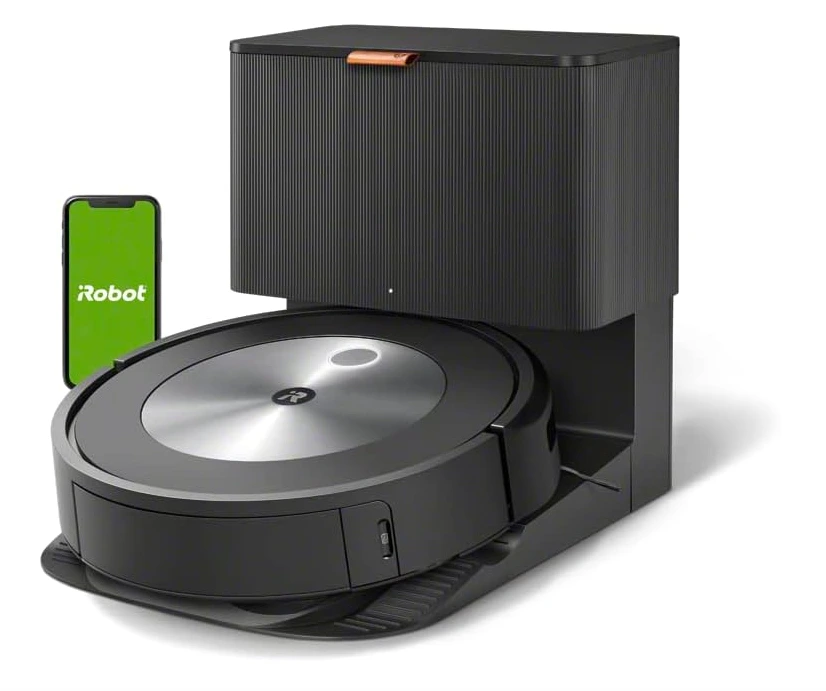
Price: $529.99
Advantages:
- Great app
- Auto-empty base
- Weight (7.48 pounds)
Disadvantages:
- High price
- Bagged
Shark RV1001AE Robot Self-Empty XL
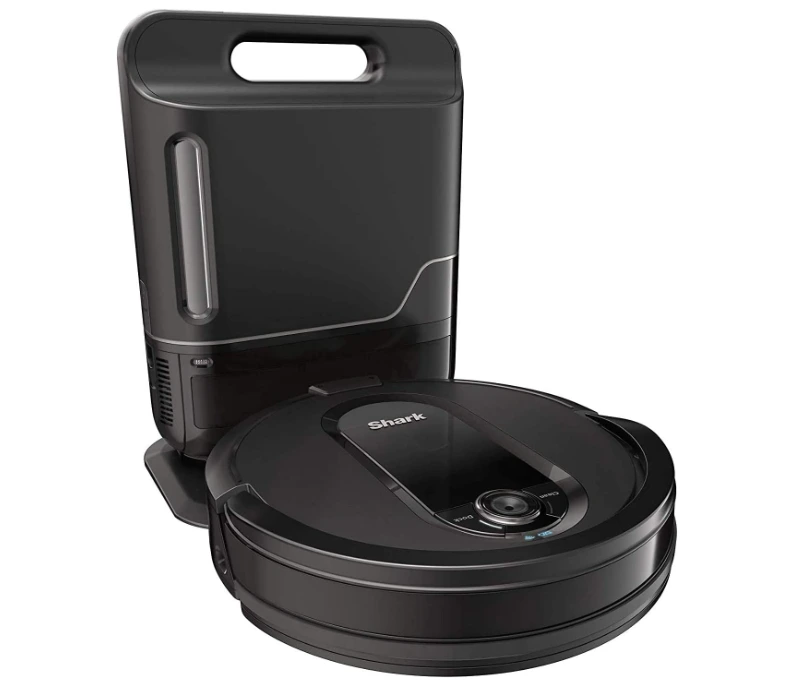
Price: $394.00
Advantages:
- Physical boundary strip
- Bagless and self-cleaning
- Price
Disadvantages:
- Battery life
- High loud
- Size
What else to consider when buying a vacuum cleaner?
Does it worth buying a cordless vacuum?
Cordless vacuums offer convenience with no cords to limit your movement. They’re great for quick clean-ups and small spaces. However, their battery life might be limited for larger areas, and they may have slightly less suction power compared to corded models. Consider your cleaning needs and the size of your home before deciding.
What if you have pets?
If you have pets, prioritize a vacuum with strong suction and specialized attachments to tackle pet hair. Look for models with HEPA filters to trap allergens effectively. Upright or canister vacuums are often recommended for pet owners due to their power and versatility.
What to know about carpet fibers?
Different carpet fibers (nylon, polyester, wool, etc.) have unique cleaning requirements. Check your carpet’s care instructions and choose a vacuum suitable for that fiber. Some vacuums have adjustable brush settings to accommodate various pile heights without damaging the fibers.
Is the higher watt, the better in vacuum cleaners?
Higher wattage doesn’t necessarily mean better performance in vacuum cleaners. While it can indicate a more powerful motor, a vacuum’s design, airflow, suction, and other factors also play a significant role in cleaning effectiveness. Consider overall features and real-world performance when evaluating a vacuum’s cleaning power.
Is a higher-volt vacuum better?
Higher voltage doesn’t necessarily equate to better performance. It might mean longer battery life for cordless models, but suction strength depends on factors beyond voltage. Consider the overall design, filtration, and user review when assessing a vacuum’s effectiveness.
What to know about vacuum cleaners’ suction?
Suction power refers to the vacuum’s ability to pull in dirt, debris, and particles from surfaces. It’s influenced by factors like the motor’s strength, airflow design, and the vacuum’s overall construction. A vacuum with strong suction is essential for deep cleaning carpets, as it enables the machine to lift embedded dirt and pet hair effectively.
However, overly powerful suction on delicate surfaces like curtains or upholstery can cause damage. Opt for vacuums with adjustable suction settings to accommodate various surfaces. Moreover, while high wattage can indicate stronger suction, it’s not the sole determinant of a vacuum’s power.
How to know if the vacuum is powerful?
Assessing the power of a vacuum involves considering various aspects of its design, performance, and specifications. One key indicator of a vacuum’s power is its motor wattage. A vacuum with a higher-wattage motor typically generates more suction power, effectively picking up dirt, dust, and debris from different surfaces. Motor power is measured in watts (W). For a powerful vacuum, typical values can start from 800 W and above. For example, powerful models can have a 1200 W or more power motor.
What to know about vacuum cleaners’ prices?
When you are buying any appliances, it is important to find out how much certain types of appliances cost. It would be foolish to overpay for a simple vacuum cleaner or, on the contrary, to look for an advanced one for too low a price. Let’s take a look at how much certain types of vacuum cleaners cost on average:
Upright Vacuum Cleaners:
- Budget range: $100 – $300
- Mid-range: $300 – $600
- Premium models: $600 – $800+
Canister Vacuum Cleaners:
- Budget range: $150 – $300
- Mid-range: $300 – $600
- Premium models: $600 – $1000+
Stick Vacuum Cleaners:
- Budget range: $50 – $150
- Mid-range: $150 – $300
- Premium models: $300 – $500+
Robot Vacuum Cleaners:
- Budget range: $100 – $300
- Mid-range: $300 – $600
- Premium models: $600 – $1000+
Handheld Vacuum Cleaners:
- Budget range: $20 – $50
- Mid-range: $50 – $100
- Premium models: $100 – $200+
Please note that these price ranges are approximate and can vary based on factors such as brand reputation, additional features, specialized functionalities (like pet hair removal), and the overall quality of the vacuum. Additionally, sales, discounts, and promotions can also impact the actual price you pay.

